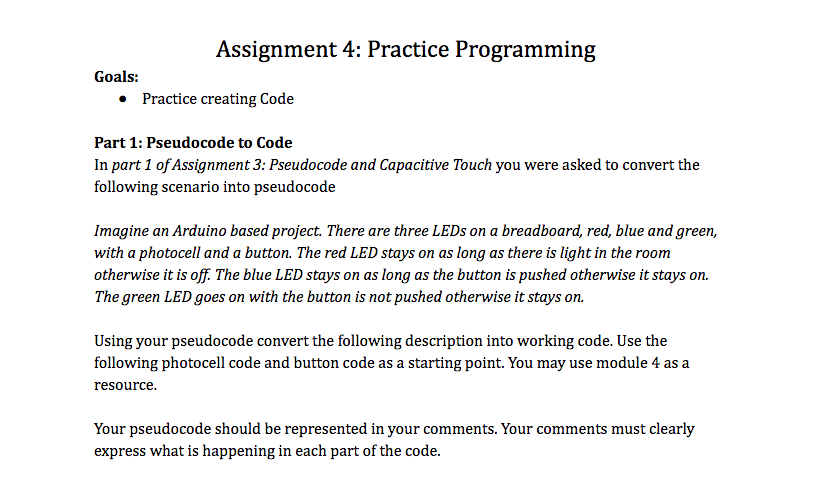Assignment 4: Practicing Programming
Goal of this Assignment: Practice the basics of programmingAssignment 4: Practicing Programming
Module: Basics in Programming Lesson
GoalsPhotocell:
/* Adapted from http://playground.arduino.cc/Learning/PhotoResistor Simple test of the functionality of the photo resistor Connect the photoresistor one leg to pin 0, and pin to +5V Connect a resistor (around 10k is a good value, higher values gives higher readings) from pin 0 to GND. ---------------------------------------------------- PhotoR 10K +5 o---/\/\/--.--/\/\/---o GND | Pin A0 o----------- ---------------------------------------------------- */ int lightPin = A0; //define a pin for Photo resistor (input) int ledPin = 13; // the pin for the led (output) void setup() { Serial.begin(9600); //Begin serial communication pinMode( lightPin, INPUT ); pinMode( ledPin, OUTPUT ); } void loop() { int lightValue = analogRead( lightPin ); Serial.println( lightValue ); //Write the value of the photoresistor to the serial monitor. // if there is not enough light if ( lightValue < 400 ) // turn on the LED digitalWrite( ledPin, HIGH ); else // otherwise, turn it off digitalWrite( ledPin, LOW ); delay(10); //short delay for faster response to light }Button:// constants won't change. They're used here to // set pin numbers: const int buttonPin = 2; // the number of the pushbutton pin const int ledPin = 13; // the number of the LED pin // variables will change: int buttonState = 0; // variable for reading the pushbutton status void setup() { // initialize the LED pin as an output: pinMode(ledPin, OUTPUT); // initialize the pushbutton pin as an input: pinMode(buttonPin, INPUT); } void loop() { // read the state of the pushbutton value: buttonState = digitalRead(buttonPin); // check if the pushbutton is pressed. // if it is, the buttonState is HIGH: if (buttonState == HIGH) { // turn LED on: digitalWrite(ledPin, HIGH); } else { // turn LED off: digitalWrite(ledPin, LOW); } }Practice


